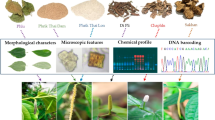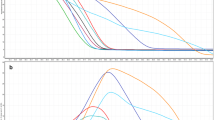Abstract
Akebiae Caulis, ‘Mùtōng’ in Chinese, refers to the stem of Akebia quinata in the Korean modern pharmacopoeia. The stems of Aristolochia manshuriensis and Clematis armandii have also been traditionally used for clinical purposes, and are often marketed as ‘Mùtōng’ under the names ‘Guān-Mùtōng and Chuān-Mùtōng’, respectively. Furthermore, due to the morphological similarity of the herbal medicines, their correct identification by traditional subjective methods is difficult. Therefore, to develop a reliable method for discriminating these three herbal medicines, we applied the tools of molecular genetics, including random amplified polymorphic DNA (RAPD) and sequence characterized amplified region (SCAR) marker development using samples of Akebia quinata, Akebia trifoliata, Aristolochia manshuriensis, and Clematis armandii. By comparative analysis of RAPD polymorphisms, we identified several potential PCR products that can be used to distinguish the herbal materials of each species. Using these RAPD products, we developed unique sequence characterized amplified region (SCAR) markers for determination of the species of plant materials; the products were 590 bp for A. quinata, 300 bp for A. trifoliata, 373 bp for A. manshuriensis, and 432 bp for C. armandii. Furthermore, we optimized SCAR markers for simultaneous discrimination of the four species by multiplex-PCR. These markers allow efficient identification of closely related herbal medicines originating from Akebia, Aristolochia, and Clematis species, and have potential uses in preventing the distribution of adulterants, as they can be used to identify each species and distinguish them from inauthentic substitutes.






Similar content being viewed by others
References
Bensky D, Clavey S, Stöger E, Gamble A (2004) Chinese herbal medicine materia medica. Eastland Press, Seattle
China Pharmacopoeia Committee (2010) Pharmacopoeia of the People’s Republic of China. China Medical Science Press, Beijing
Choo BK, Moon BC, Ji Y, Kim BB, Choi G, Yoon T, Kim HK (2009) Development of SCAR markers for the discrimination of three species of medicinal plants, Angelica decursiva (Peucedanum decursivum), Peucedanum praeruptorum and Anthricus sylvestris, based on the internal transcribed spacer (ITS) sequence and random amplified polymorphic DNA (RAPD). Biol Pharm Bull 32:24–30
Dnyaneshwar W, Preeti C, Kalpana J, Bhushan P (2006) Development and Application of RAPD-SCAR Marker for Identification of Phyllanthus emblica LINN. Biol Pharm Bull 29:2313–2316
Fushimi H, Komatsu K, Isobe M, Namba T (1997) Application of PCR-RFLP and MASA analyses on 18S ribosomal RNA gene sequence for the identification of three Ginseng drugs. Biol Pharm Bull 20:765–769
Han SW, Kim SC, Yang CH, Seo JC (2004) Genetical identification of Akebia and Aristolochia species by using pyrosequencing. J Biotechnol 120:360–363
Jigden B, Wang H, Kin YJ, Samdan N, In JG, Yang DC (2010) Molecular identification of oriental medicinal plant Schizonepeta tenuifolia bunge (Hyung-Gae) by multiplex PCR. Plant Biotech Rep 4:223–228
Joshi K, Chavan P, Warude D, Patwardhan B (2004) Molecular markers in herbal drug technology. Curr Sci 87:159–165
Jung BS, Shin MK (1998) Encyclopedia herbs. Young-Lim Press, Seoul
Kitaoka F, Kakiuchi N, Long C, Itoga M, Mitsue A, Mouri C, Mikage M (2009a) Molecular characterization of Akebia plants and the derived traditional herbal medicine. Biol Pharm Bull 32:665–670
Kitaoka F, Kakiuchi N, Long C, Itoga M, Yoshimatsu H, Mitsue A, Atsumi T, Mouri C, Mikage M (2009b) Difference of ITS sequences of Akebia plants growing in various parts of Japan. J Nat Med 63:368–374
Korea Food and Drug Administration (2012) The Korean herbal pharmacopoeia. Korea Food and Drug Administration, Seoul
Lee MY, Doh EJ, Kim ES, Kim YH, Ko BS, Oh SE (2008) Development of SCAR marker for discrimination of Artemisia princeps and A. argyi from other Artemisia herbs. Bio Pharm Bull 29:629–633
Lim JH, Jin DC, Sung JS, Bang KH, Kim OT, Cha SW, Park HW (2007) Discrimination of Astragalus membranaceus (Fisch) Bunge from A. membranaceus (Fisch) Bunge var. mongholicus (Bunge) with SCAR marker. Kor J Med Crop Sci 15:51–55
Ministry of Health, Labour and Welfare (2011) The Japanese herbal pharmacopoeia. Ministry of Health, Labour and Welfare, Tokyo
Moon BC, Choo BK, Chen MS, Yoon T, Ji Y, Kim BB, Lee AY, Kim HK (2010) Rapid molecular authentication of three medicinal plant species, Cynanchum wilfordii, Cynanchum auriculatum, and Polygonum multiflorum (Fallopia multiflorum) by the development of RAPD-derived SCAR markers and multiplex-PCR. Plant Biotech Rep 4:1–7
Moon BC, Ji Y, Lee YM, Chun JM, Lee AY, Choo BK, Kim HK (2011) Development of SCAR markers for the authentication of Acori Rhizoma based on the analysis of RAPD and multiplex-PCR. Kor J Med Crop Sci 19:162–169
Paran I, Michelmore RW (1993) Development of reliable PCR-based markers linked to downy resistance genes in lettuce. Theor Appl Genet 85:985–993
Penner GA, Bush A, Wise R, Kim W, Momier L, Kasha K, Larochee A, Scoles G, Molnar SJ, Fedak G (1993) Reproducibility of random amplified polymorphic DNA (RAPD) analysis among laboratories. PCR Meth Appl 2:341–345
Qiu Q, Liu ZH, Chen HP, Yin HL, Li LS (2000) Long-time outcome of acute renal injury induced by Aristolochia manshuriensis Kom in rats. Acta Pharmacol Sin 21:1129–1135
Shen J, Ding X, Liu D, Ding G, He J, Li X, Tang F, Chu B (2006) Inter simple sequence repeats (ISSR) molecular fingerprinting markers for authenticating populations of Dendrobium officinale KIMURA et MIGO. Biol Pharm Bull 29:420–422
Shucher NJ, Carles MC (2008) Genome-based approaches to the authentication of medicinal plants. Planta Med 74:603–623
Vos P, Hogers R, Bleeker M, Reijans M, van de Lee T, Hornes M, Frijters A, Pot J, Peleman J, Kuiper M (1995) AFLP: a new technique for DNA fingerprinting. Nucleic Acids Res 23:4407–4414
Wang J, Ha WY, Ngan FN, But PP, Shaw PC (2001) Application of sequence characterized amplified region (SCAR) analysis to authenticate Panax species and their adulterants. Planta Med 67:781–783
Williams JG, Kubelik AR, Livak KJ, Rafalski JA, Tingey SV (1990) DNA polymorphisms amplified by arbitrary primers are useful as genetic markers. Nucleic Acids Res 18:6531–6535
World Health Organization (1998) Quality control methods for medicinal plant materials. World Health Organization, Geneva
Zhang YB, Shaw PC, Sze CW, Wang ZT, Tong Y (2007) Molecular authentication of Chinese herbal materials. J Food Drug Anal 15:1–9
Acknowledgments
We thank ‘The Classification and Identification Committee of the Korea Institute of Oriental Medicine’ for the critical authentication of plant materials and for helpful discussions. This work was supported by the ‘Construction of the Basis for Practical Application of Herbal Resources’ (K09020) and ‘Development of Basic Technologies for the Domestic Cultivation of Herbal Medicine Resources’ (K14417) funded by the Ministry of Science, ICT and Future Planning (MSIP) of Korea to the Korea Institute of Oriental Medicines (KIOM).
Conflict of Interest
The authors, Byeong Cheol Moon, Yunui Ji, Young Mi Lee, Young Min Kang, and Ho Kyoung Kim, declare that there are no conflict of interest.
Author information
Authors and Affiliations
Corresponding author
Additional information
Byeong Cheol Moon and Yunui Ji have contributed equally to this work.
Rights and permissions
About this article
Cite this article
Moon, B.C., Ji, Y., Lee, Y.M. et al. Authentication of Akebia quinata DECNE. from its common adulterant medicinal plant species based on the RAPD-derived SCAR markers and multiplex-PCR. Genes Genom 37, 23–32 (2015). https://doi.org/10.1007/s13258-014-0225-6
Received:
Accepted:
Published:
Issue Date:
DOI: https://doi.org/10.1007/s13258-014-0225-6




